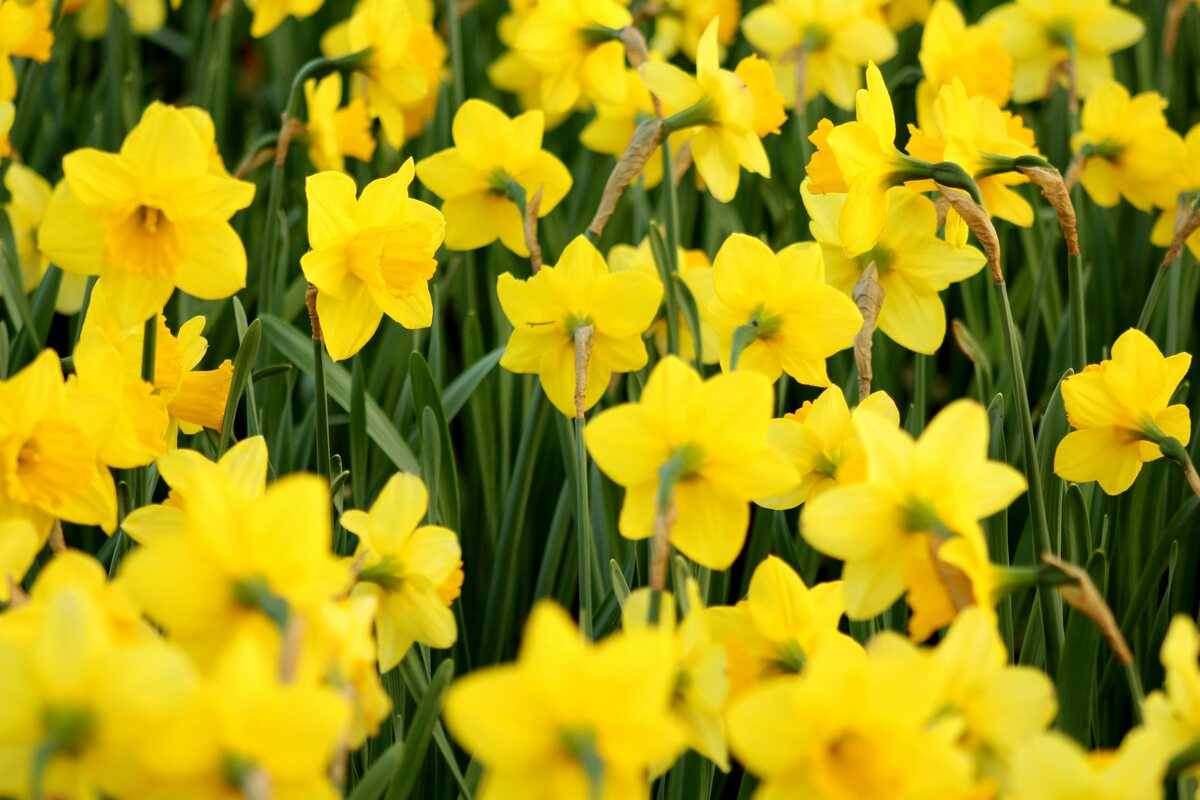
New Hampshire is known for cold, snowy weather, but that doesn’t mean your yard has to be barren during the winter season. You can brighten it up with beautiful winter plants that handle cold winters like a cool breeze. Check out these nine plants that flower in New Hampshire’s cold winters.
- Blooming Winter Flowers
- 1. Cornelian Cherry (Cornus mas)
- 2. Daffodil (Narcissus)
- 3. Japanese Pieris (Pieris japonica)
- 4. Ornamental Kale and Cabbage (Brassica oleracea)
- 5. Sieber’s Crocus (Crocus sieberi)
- 6. Snowdrop (Galanthus nivalis)
- 7. Winter Aconite (Eranthis hyemalis)
- 8. Winter Heath (Erica carnea)
- 9. Winter Jasmine (Jasminum nudiflorum)
- Understanding New Hampshire’s Climate
- FAQ
Blooming Winter Flowers
1. Cornelian Cherry (Cornus mas)
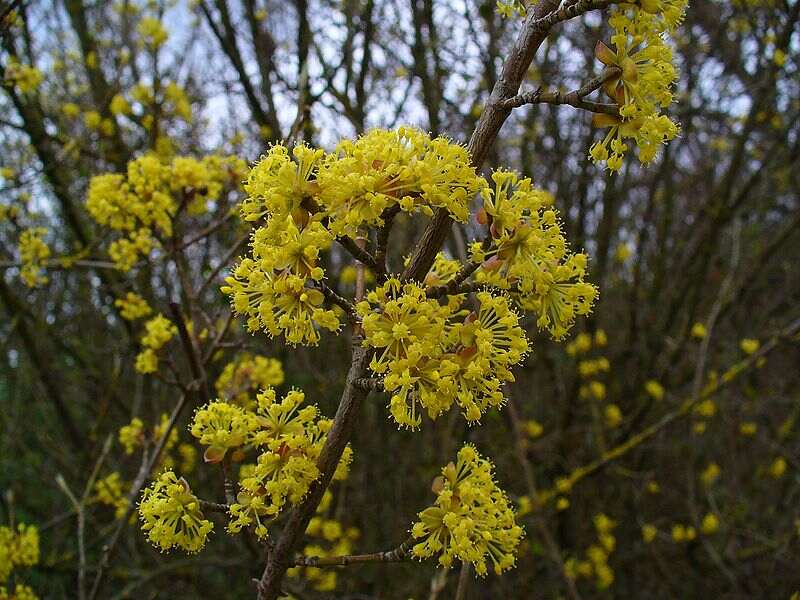
Blossoms in late winter, fruit in the summer — Cornelian cherry brings the whole package. Its fruit is quite sour, but it can be processed into jams, jellies, and syrups. If you want it to create a little privacy, that’s not a problem either; Cornelian cherry can grow up to 25 feet tall or be grown as a hedge.
Fun fact: The shrub’s name is actually a misnomer; it’s not a cherry but a dogwood. Although it’s unsuitable for pets, you can certainly leave the fruit for local wildlife, like birds.
- Bloom time: Late winter to early spring
- Hardiness zones: 4 to 8
- Sun: Full sun, partial shade
- Water needs: Keep the soil moist at all times; while growing, the tree needs frequent watering, but mature trees can usually live off rainwater unless the weather gets too hot or when there’s no rainfall
- Soil: Slightly acidic to slightly alkaline, well-drained soil; preferably moist and organically rich, but tolerates clay-based
- Duration: Perennial
- Mature height: Up to 25 feet tall
- Potential hazards: None known; can cause issues if eaten by pets, though
2. Daffodil (Narcissus)
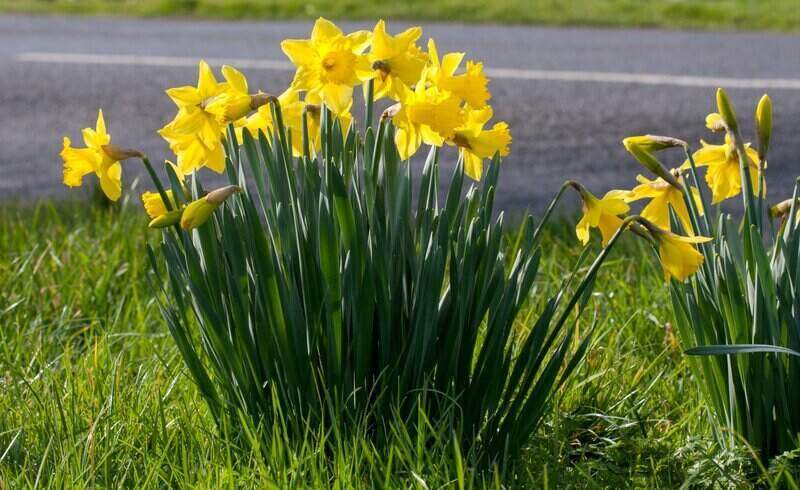
Daffodil is a spectacular and hardy bulb that’s super easy to care for and thrives in a variety of soil types, making it a great choice for beginners and advanced gardeners alike. And of course, planting these daffodil stunners in your yard is a great way to brighten it up with a pop of color.
Originating in Europe and northern Africa, daffodils have spread throughout the world, including into New Hampshire gardens. Planted in the fall, typically in October, these blooms will spring to life late in the winter, providing a preview of all the beautiful spring colors that will soon adorn your landscaping.
- Bloom time: Late winter to early spring
- Hardiness zones: 4 to 8
- Sun: Ideally full sun, tolerates partial shade
- Water needs: 1 inch of water a week while they’re growing and blooming; water twice as much if your daffodils are planted near shrubs or under trees
- Soil: Fertile, rich, loose, loamy, and well-drained soil; ideally slightly acidic, but tolerates neutral; not too wet
- Duration: Perennial
- Mature height: Up to about 16 inches
- Potential hazards: Toxic
3. Japanese Pieris (Pieris japonica)
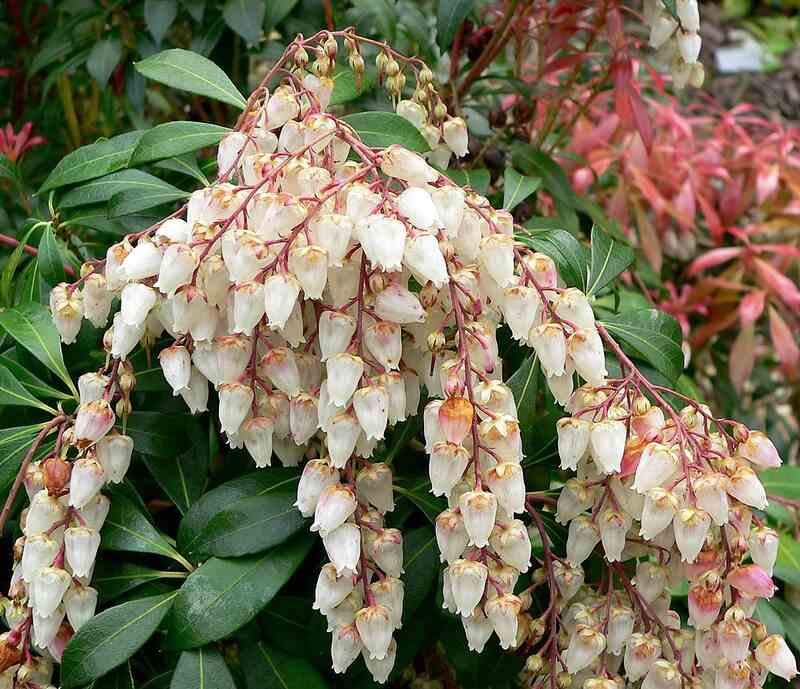
Known as Japanese andromeda or lily-of-the-valley bush, Japanese pieris is a popular evergreen bush that produces clusters of small, bell-shaped flowers in late winter to early spring. When it gets warm enough, the flowers attract bees.
As one of its names suggests, its flowers resemble lilies of the valley, although their fragrance is not as strong. Also, take note that this bush is more suitable for the southern part of New Hampshire.
Nevertheless, the Japanese pieris is a striking showpiece that can be used as a focal point in a garden or as a hedge. Shorter cultivars are also available for smaller spaces.
- Bloom time: Late winter to early spring
- Hardiness zones: 5 to 8
- Sun: Full sun, partial shade
- Water needs: Keep the soil moist at all times; water to about 3 inches deep once a week if there’s not enough rainfall
- Soil: Moist but well-drained, rich in organic matter, acidic soil
- Duration: Perennial
- Mature height: 9 to 12 feet tall
- Potential hazards: Severely toxic; be careful with your children and pets
4. Ornamental Kale and Cabbage (Brassica oleracea)
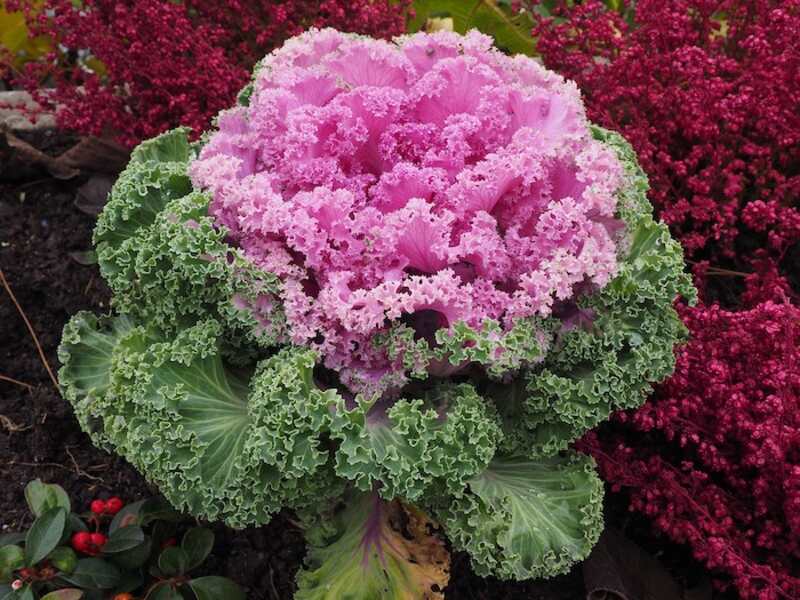
Ornamental kale and cabbage are like winter accessories for your yard. They add vibrancy during those snowy days. The rose blossom-shaped white and purple leaves of the plants make them popular with gardeners who want to add some color to their winter landscapes.
They especially stand out in a group setting. Plus, ornamental kale and cabbage can look great as a garnish on your dinner plate.
- Bloom time: From fall to winter
- Hardiness zones: 2 to 11
- Sun: Full sun is ideal in New Hampshire, but some partial shade is OK, especially in warmer climates
- Water needs: An inch of water per week
- Soil: Consistently moist but not soggy, organically rich, loamy, well-drained soil; preferably slightly acidic
- Duration: Annual
- Mature height: 12 to 18 inches tall and wide
- Potential hazards: The plant has poisonous roots; the whole plant is also problematic for pets, so don’t let them eat it
5. Sieber’s Crocus (Crocus sieberi)
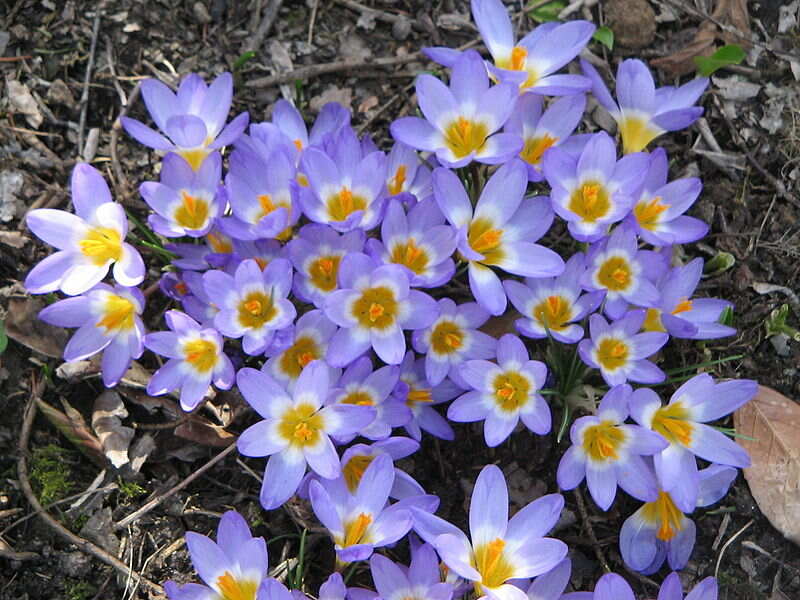
These blooming beauties will adorn your yard with purple flowers in late winter to early spring. Sieber’s crocus is not just a real beauty, but it’s also resistant to cold and snow. These flowers have even been known to pop up amidst a snowy garden.
Crocus species do well in New Hampshire in general, though, so feel free to check out other varieties and combine them to your liking. They are also a valuable food source for bees and other pollinators.
- Bloom time: Late winter to early spring
- Hardiness zones: 3 to 8
- Sun: Full sun, partial shade
- Water needs: Water once a week; more frequently during the summer when the weather gets hot
- Soil: Average, medium moisture, slightly acidic to slightly alkaline, well-drained soil; thrives in sandy and gritty soils, doesn’t like heavy clay
- Duration: Perennial
- Mature height: 6 inches tall
- Potential hazards: Severely toxic; be careful
6. Snowdrop (Galanthus nivalis)
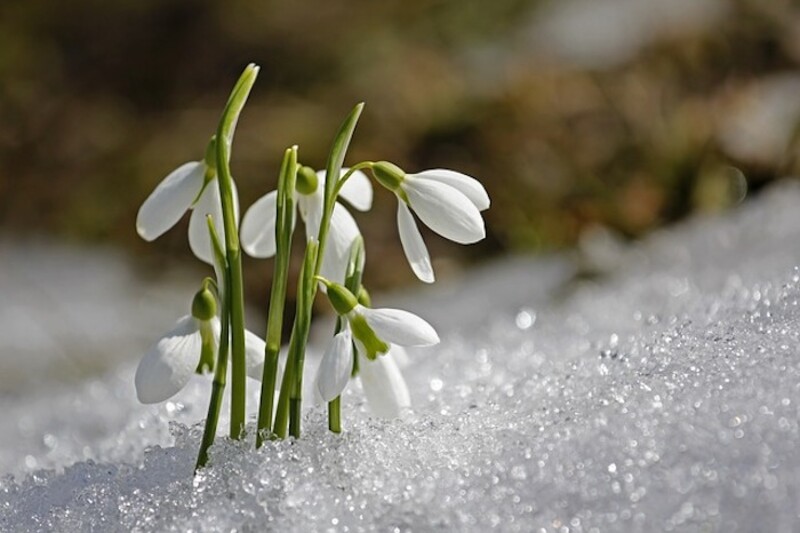
With spectacular flowers that bloom in late winter to early spring, snowdrop plants produce delicate white blossoms that hang from their thin green stems. Not only does it bloom while snow is still on the ground, but it even lives up to its name with its snow-white petals that look like droplets.
Snowdrop plants tend to be easy to care for and will make themselves at home in a winter garden, rock garden, or pollinator garden.
- Bloom time: Late winter to early spring
- Hardiness zones: 3 to 9
- Sun: Full sun, partial shade
- Water needs: Water in dry weather; water should have a slightly acidic pH; tap water may be too alkaline
- Soil: Clay, high in organic matter, loam, well-drained, occasionally wet soil, acidic to neutral
- Duration: Perennial
- Mature height: 4 to 10 inches
- Potential hazards: Toxic
7. Winter Aconite (Eranthis hyemalis)
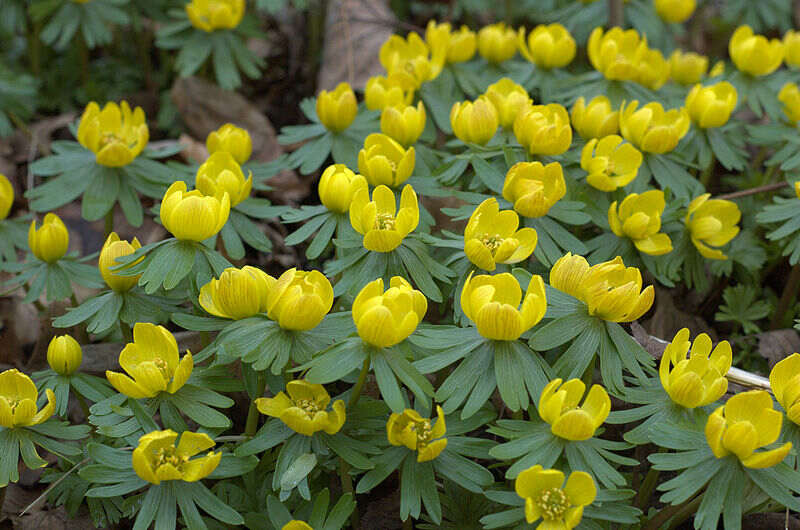
This ground-hugging plant stands out for its yellow, buttercup-like flowers that provide a source of nectar for bees when they become active. Native to southeast France, winter aconite is a great way to add a splash of color to walkways, rock gardens, beds, and woodland gardens.
The lovely winter aconite likes to peek through blankets of snow, cheerfully signaling the end of winter and the arrival of spring. It’s likely to spread throughout your garden, so you’ll need to keep it in check.
- Bloom time: Late winter to early spring
- Hardiness zones: 3 to 7
- Sun: Full sun, partial shade
- Water needs: Needs year-round moisture, but while you may need to water more than twice a week in summer, watering is sparsely needed in winter
- Soil: Moist, moderately fertile, well-drained soil rich in organic material, with preferably slightly alkaline pH
- Duration: Tuberous perennial
- Mature height: 6 inches tall
- Potential hazards: One of the most toxic species; be careful
8. Winter Heath (Erica carnea)
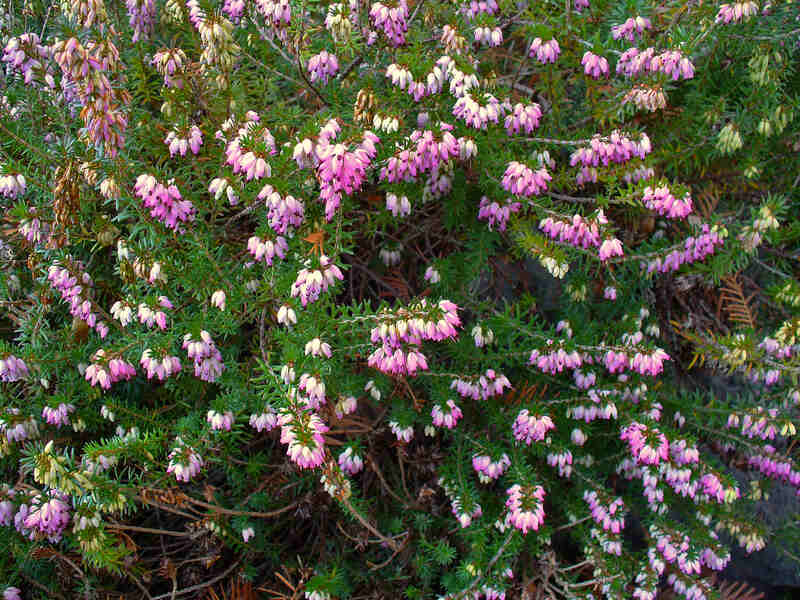
If you’re in the south of New Hampshire, plant winter heath, a purple, pink, or white evergreen shrub that’s sure to brighten up your yard during the cold months. This early winter bloomer is easy to care for and thrives in the sun.
It can also tolerate a little shade, but it may make its stems too long, affecting its appearance. Be sure not to fertilize this plant; it has a symbiotic relationship with soil fungi, so it gets enough nutrients unless it’s in a pot.
- Bloom time: Early winter to early spring
- Hardiness zones: 5 to 7 (some cultivars may live in zone 4)
- Sun: Full sun
- Water needs: Once or twice a week during the first season, when soil is dry; mature plants rarely need watering as they become resistant to dry conditions
- Soil: Ideally sandy, acidic, medium moisture, well-drained soil
- Duration: Perennial
- Mature height: Up to 9 inches tall
- Potential hazards: Some reports of toxicity; practice caution
9. Winter Jasmine (Jasminum nudiflorum)
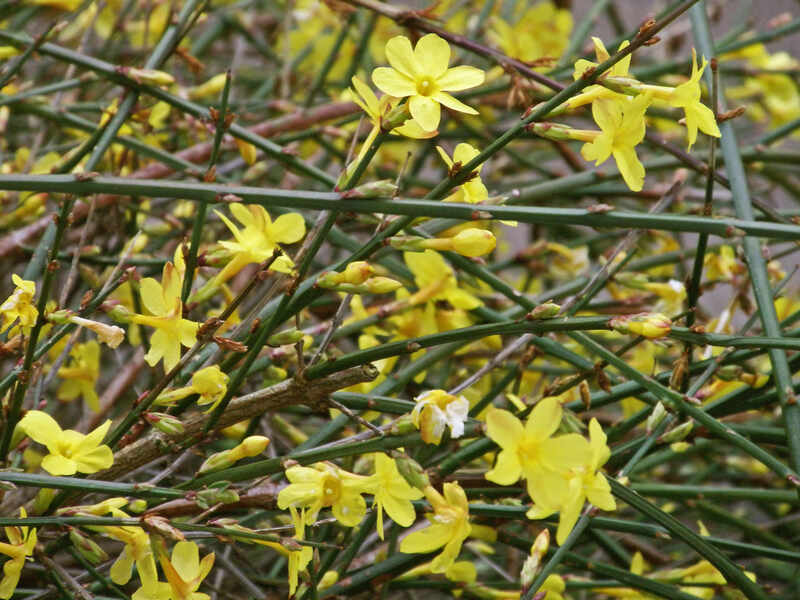
If you’re in southern New Hampshire and want your yard to be covered in delicate yellow flowers throughout the winter, consider planting winter jasmine. This plant grows as a groundcover or climbs up to 15 feet on a trellis. While it’s non-fragrant, it can cheer up your outdoor area with its green foliage and late-winter blooms.
This stunner of a plant is sometimes confused with the similar-looking forsythia, but unlike forsythia, winter jasmine blooms in the winter and isn’t known to be toxic.
- Bloom time: Late winter
- Hardiness zones: 6 to 9
- Sun: Full sun, partial shade
- Water needs: Higher than average, top of soil must not be dry; water once a week; more frequently during the summer when the weather gets hot
- Soil: Ideally fertile, loamy soil rich in organic matter, but the plant isn’t picky and can do fine in poor soil; soil needs to be moist but not overwatered and well-drained
- Duration: Perennial
- Mature height: Up to 4 feet tall, but can grow up to 15 feet tall on a trellis
- Potential hazards: None known, but caution is always advised; also, don’t confuse the plant for the toxic forsythia
Understanding New Hampshire’s Climate
While all of New Hampshire gets pretty chilly during the winter months, the climate varies depending on the region. Northern New Hampshire experiences colder temperatures and more snowfall than the southern part of the state. That’s why it’s important to know your hardiness zone.
FAQ
Which Flower Blooms All Winter?
Technically, they’re not blooming flowers, but ornamental cabbage and kale are known for their colorful foliage that lasts throughout the winter months.
What Plant Can Grow Early in Winter?
Most winter plants don’t blossom until late winter. But if you plant winter heath, you can expect it to grow as early as December or January.
What Winter Flowering Plant is Easy to Grow?
Many of the aforementioned plants are easy to grow. For example, you can try growing snowdrops, daffodils, winter heath, or ornamental kale and cabbage.
Call a Lawn Care Pro
Once you’ve made it through winter, be sure you know the best spring lawn care tips for your New Hampshire lawn. If planting a new lawn from scratch is part of your spring lawn care plan, take into consideration the best grass seed for New Hampshire before going out and buying whatever you find.
Another key to successful landscaping is to feature plants native to New Hampshire. This ensures a low-maintenance yard that will be sure to have all the neighbors asking you for landscaping advice.
If you need some help, be sure to get in touch with a local New Hampshire landscaper to keep your landscape vibrant all year long. Whether you’re in Salem, Pelham, Hudson – or anywhere else in the great state of New Hampshire – LawnStarter can connect you with passionate lawn care and landscaping pros with helpful advice.
Main Image Credit: Daffodils / Pexels